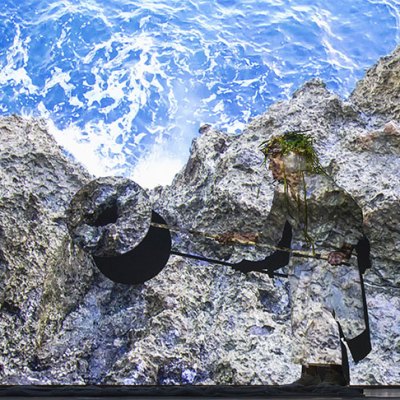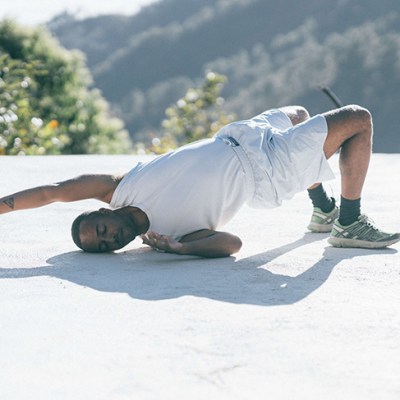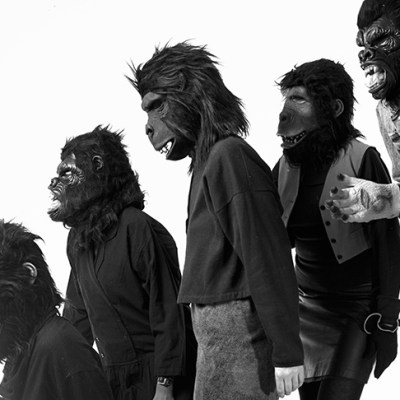Eleanor Antin initially made Carving: A Traditional Sculpture (1972) for the Whitney Annual. Back then, the exhibition strictly featured painting and sculpture, and Antin claimed that her work – 148 black-and-white photographs documenting her unclothed body as it shed 10 pounds over 37 days of crash-dieting – was the latter, a sculptural carving of her own form. Whitney curators balked at this logic and rejected the piece. But over subsequently decades it became revered as a provocative feminist take on body image and the reinvention of the self, and a smart jab at minimalist seriality – Antin hung all the photos in an orderly grid. Nearly half a century later, in 2017, shortly after the death of her husband, the poet David Antin, she decided to revisit the project. ‘Maybe it was that I lost him, and then I lost part of myself,’ she said in an interview at the time. ‘It helped also as I knew when he died I had to get working immediately.’
For Carving: 45 Years Later Antin dieted again, and again photographed herself naked, from front, back and both sides. She also took one photo each day of herself in a bra, to lift up her breasts and better show the changing contours of her stomach. But this time it took longer – 100 days – to shave off the weight. The 500 new photographs now hang in a grid across from the original Carving in ‘Eleanor Antin: Time’s Arrow’, an intimate, single-gallery exhibition at the Los Angeles County Museum of Art. With this second Carving, Antin has reopened a conversation already neatly framed in feminist art history, and managed again to unsettle assumptions about where the personal meets the conceptual, and about beauty and biases in a world that often equates signs of ageing with imperfection. ‘This is riskier than the first one,’ the artist Barbara T. Smith told me at the opening of ‘Time’s Arrow’ – Smith, also in her eighties, has made work about the ageing body as well.
CARVING: A Traditional Sculpture (1972), Eleanor Antin. Photo: © Museum Associates/LACMA. Courtesy the artist and Ronald Feldman Gallery, New York; © Eleanor Antin
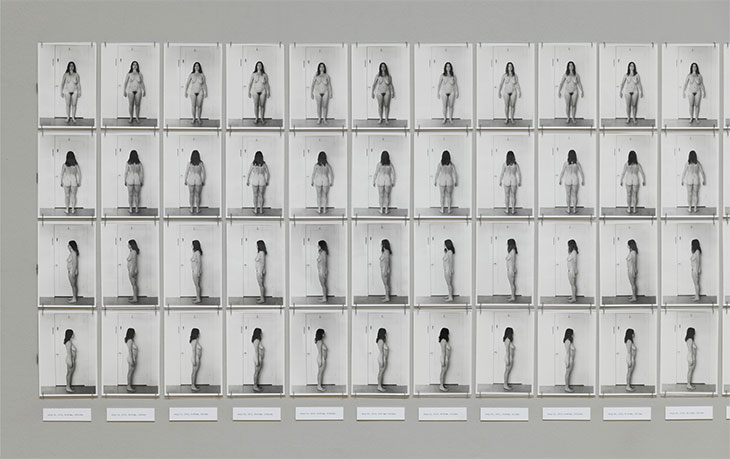
When Antin created the first Carving, the work wasn’t so much about her as about the conventions of art-making (carving, repetition, the grid) and femininity (beauty is pain). Antin also set out to challenge notions of ‘documentation’, poking intentionally at her conceptualist peers who tended to use dry documentary images as stand-ins for actions or ideas. ‘Contrary to their belief, documentation is not a neutral list of facts. It is a conceptual creation of events after they are over,’ she wrote in 1974. ‘All “description” is a form of creation.’ The typed text panel that always hangs besides Carving: A Traditional Sculpture discusses the ‘limitations of the material’, the material being the artist’s body, and describes physical exercise as an artistic ‘technique’. The work, the text says, was complete ‘when the image was finally refined to the point of aesthetic satisfaction’: her body, slim but not too slim, with smoother curves and contours, looked a little more like ‘the ideal image to which the artist aspires’ by the end.
CARVING: 45 Years Later (detail, first day of 2017 performance, March 7 2017, 9:25 am, 130.6 lbs) (2017), Eleanor Antin. Courtesy the artist and Ronald Feldman Gallery, New York; © Eleanor Antin

The text hanging beside the new Carving is less wry, and less heady. Antin talks about how she was too embarrassed to start photographing herself until she’d lost the first few pounds; about discovering a small hernia near her belly button once she began to lose weight; and about death. The photos, stacked in columns of five, extend across a long grey-painted wall, and her body changes almost imperceptibly from one column to the next. She has many more sags and wrinkles, but also long, still-brunette hair with a fringe, and a face that has become more quizzically mirthful and compelling over the years.
In 2013, the choreographer Mette Ingvartsen asked Carolee Schneemann to remake her well-known 1964 work Meat Joy, in which performers danced and writhed with raw meat, in order to ‘transform’ the performance ‘with older bodies’. Schneemann said no. Writing in a letter later published in Harper’s Magazine, she said, ‘Popular culture only introduces subjects of ageing or old age as anomalous, sorrowful, or ridiculously optimistic.’ She did not want her work to become part of this already over-determined conversation about ageing bodies. Other artists who choose to perform into their eighties do contend with patronising perspectives. When in 2017 Simone Forti performed at Danspace in New York with friends Steve Paxton and Yvonne Rainer, the New York Times described her as ‘the frailest-looking of the three, her hands shaking from Parkinson’s disease’, noting that ‘she needed help from the others to rise from the floor’. The Times failed to mention that Forti can still do somersaults, but such are the perils of being old in public: observers may see only frailty when so much else is there.
!!! (2017), Eleanor Antin. Photo: © Museum Associates/LACMA.
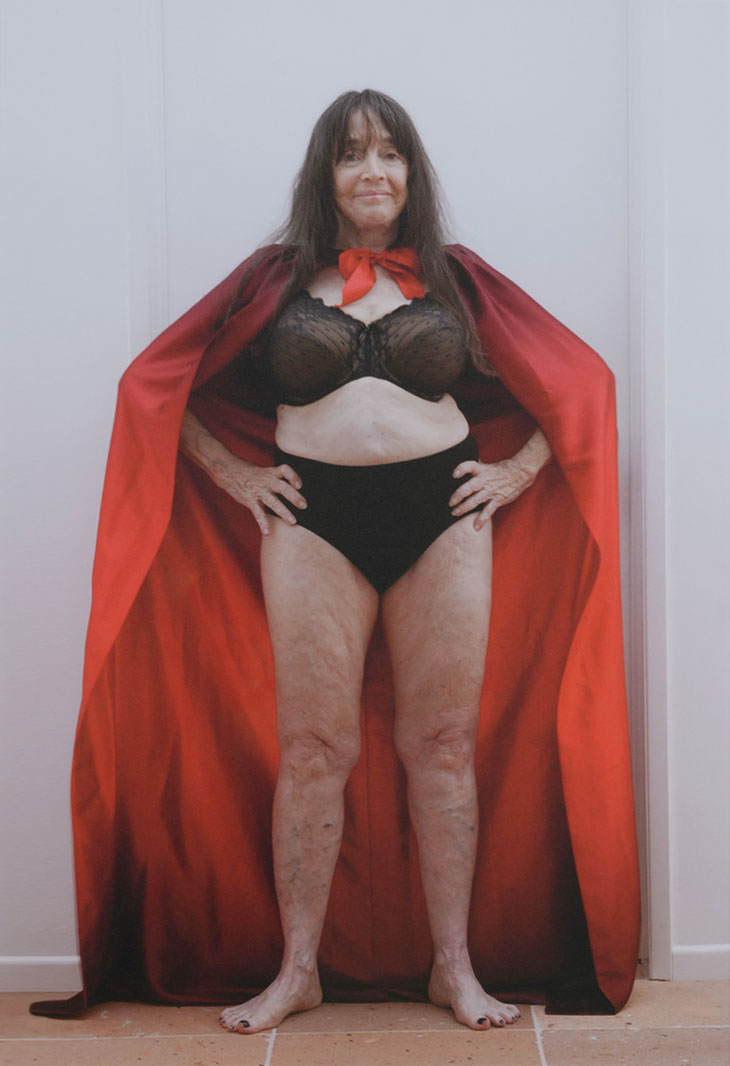
With ‘Time’s Arrow’, Antin reminds her viewers repeatedly that she is funny and biting, as well as ageing. Her work between the first Carving and the second ventured into what Martha Rosler, once called ‘sentimentalised, mock-heroic performance’. She created alter egos (such as Russian ballerina Eleanora Antinova), and lushly restaged Greek myths. In the exhibition at LACMA, between the two Carvings and adjacent to The Eight Temptations (1972) – eight sparsely composed photographs of Antin refusing various food items – hangs the newest work, !!! (2017). In the large photograph, the artist wears lacy black lingerie and a red cape, her hands on her hips, and an inquisitive, sceptical look in her eyes. She is a superhero who does not take herself too seriously, happily complicating her legacy.
‘Eleanor Antin: Time’s Arrow’ is at the Los Angeles County Museum of Art until 28 July.

